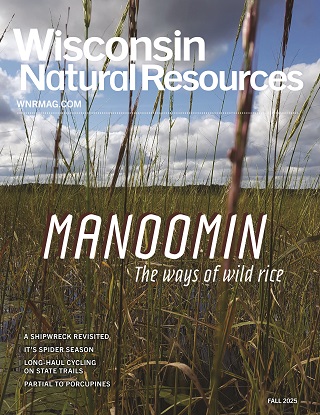Contact: DNR Office of Communications
DNRPress@wisconsin.gov
Take Action To Reduce Algae Blooms In Wisconsin Waterbodies
MADISON, Wis. – The Wisconsin Department of Natural Resources (DNR) reminds Wisconsinites of blue-green algae risks and simple steps to help reduce algae blooms.
Blue-green algae, or cyanobacteria, are photosynthetic bacteria often called "pond scum." Blue-green algae are most often green but can also be blue, tan, reddish-purple or brown. Blue-green algae generally grow in lakes, ponds and slow-moving streams when the water is warm and enriched with nutrients like phosphorus or nitrogen.
When environmental conditions are just right, blue-green algae can increase in number. Most species are buoyant and will float to the surface, where they form scum layers or floating mats known as a "blue-green algae bloom." In Wisconsin, blue-green algae blooms generally occur between mid-June and late September, although in rare instances, blooms have been observed in winter, even under the ice.
Concerns associated with blue-green algae include discolored water, reduced light penetration, taste and odor problems, dissolved oxygen depletion during die-off and toxin production. In addition to environmental concerns, contact with blue-green algae blooms can be dangerous for humans and pets. To keep loved ones safe, the DNR urges, "When in doubt, stay out!"
STOP ALGAE AT THE SOURCE
There are no quick or easy remedies to control blue-green algae once they appear in a lake or pond. Reducing the amount of nutrients that wash into Wisconsin lakes and ponds will eventually reduce the frequency and intensity of blue-green algae blooms. Still, scientists warn it may take a long time and a lot of community involvement to change the nutrient concentrations in a water body effectively. This is because there may still be significant amounts of nutrients in bottom sediment continuing to serve as food for the blue-green algae.
Regulatory agencies like the Wisconsin DNR and Wisconsin Department of Agriculture, Trade, and Consumer Protection (DATCP) work with communities around the state to reduce stormwater runoff and encourage agricultural practices that reduce soil erosion while maintaining high crop yields and promoting soil health.
Locally, landowners and interested citizens can help minimize problems associated with algal blooms by working together with partners in their watershed to reduce the amount of nutrients that reach nearby lakes, streams and ponds.
Citizens can reduce nutrient concentrations by promoting the following practices in their communities:
- Use lawn fertilizers only where truly needed. Wisconsin has prohibited the use of lawn fertilizers containing phosphorus (except for establishing new lawns) since 2010.
- Prevent yard debris (e.g., leaves, grass clippings, etc.) from washing into storm drains.
- Support local ordinances that require silt curtains for residential and commercial construction sites.
- Plant and maintain vegetative buffer strips along shorelines of lakes, ponds and streams. Note: Native plants are much more effective at filtering runoff than the typical grass species found on residential lawns.
- Test soil with resources from The University of Wisconsin Division of Extension.
The public is encouraged to report significant blue-green algae blooms to the DNR at DNRHABS@wisconsin.gov. Please include the location of the bloom, the name of the water body, nearest town, county, the size and duration of the bloom and overall and close-up photographs for verification. The DNR is unable to test all reported blooms.
For more information on blue-green algae, including symptoms of exposure and environmental concerns, visit the DNR Blue-Green Algae webpage. More information is also available via the Wisconsin Department of Health Services.

